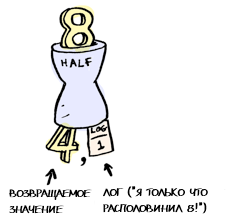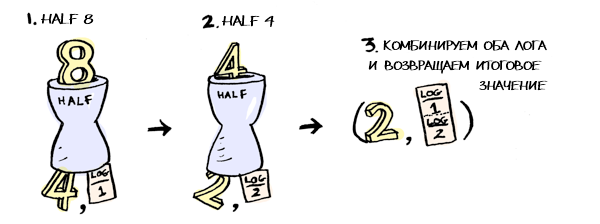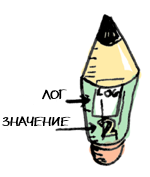Three useful monads
Warning: before reading the text below, you should already have an idea of what monads are. If this is not the case, then read this post before!
Before us function

And we can apply it several times:
')
Everything works as expected. But you decided that it would be nice to have a log of what is happening with this function:

Well, great. But what if you now want to apply
Here is what we would like to happen:

Spoiler : not automatically done. We'll have to paint everything handles:
Ugh! This is not a drop like laconic
And what if you still have functions that have a log? This scheme suggests itself: for each function that returns, together with the value of the log, we would like to combine these logs. This is a side effect, and no one is as strong in side effects as monads!

The monad Writer appears on thewhite horse
Monad Writer is a cool personality. “Don't worry, man, I'll process your logs,” she says. - “Go back to your clean code and squeeze the maximum for anything from Zeppelin!”
Each Writer instance has a log and a return value:

Writer allows us to write code like
Well, or you can use the
which is damn close to
You can use
It returns

And we can use

But the coolest thing is that now we can link the
Here is what happens:

Magically

We wrote the exact same template code earlier, but now we have assumed this responsibility

( Note : this definition is almost correct. In fact, the
Thank you, monad Writer!
Suppose you want to pass some settings to a variety of functions. Just use the Reader monad:

It allows you to transfer your value to all functions, hiding the transmission mechanism itself behind the scenes. For example:

Here is its definition:
Reader has always been a turncoat. Dark horse. Reader is different because it allows us to process a function, which is confusing when considering it. But you and I understand that we can use

And we can transfer a certain state to this function, which is then used in

this way, when you use

Reader has always been somewhat comprehensive. This is generally his best quality.

And, finally,
Want to spend more time with Reader? Cut punk rock and take a look at a longer example .
The Monad State is the more impressionable best friend of the Reader monad:

It is exactly the same as the Monad Reader, but with its help you can not only read but also write!
Here is the definition of

You can get a state with
Nicely! If the Reader was with the character “you-me-not-change”, then State, on the contrary, tends to relations and is ready to change itself.
The definition of a



Writer. Reader. State. Today you have added three powerful weapons to your Haskell arsenal. Use them wisely.
From the translator: I will be infinitely grateful for any comments in PM that will help improve the quality of this translation.
Before us function
half :
And we can apply it several times:
half . half $ 8 => 2 ')
Everything works as expected. But you decided that it would be nice to have a log of what is happening with this function:

half x = (x `div` 2, " " ++ (show x) ++ "!") Well, great. But what if you now want to apply
half few times? half . half $ 8 Here is what we would like to happen:

Spoiler : not automatically done. We'll have to paint everything handles:
finalValue = (val2, log1 ++ log2) where (val1, log1) = half 8 (val2, log2) = half val1 Ugh! This is not a drop like laconic
half . half $ 8 And what if you still have functions that have a log? This scheme suggests itself: for each function that returns, together with the value of the log, we would like to combine these logs. This is a side effect, and no one is as strong in side effects as monads!
Monad Writer

The monad Writer appears on the
Monad Writer is a cool personality. “Don't worry, man, I'll process your logs,” she says. - “Go back to your clean code and squeeze the maximum for anything from Zeppelin!”
Each Writer instance has a log and a return value:

data Writer wa = Writer { runWriter :: (a, w) } Writer allows us to write code like
half 8 >>= half Well, or you can use the
<=< function, which is the composition of functions for monads, to get: half <=< half $ 8 which is damn close to
half . half $ 8 half . half $ 8 . Cool!You can use
tell to write something to the log. And return will pass this value to Writer. Here is our updated half function: half :: Int -> Writer String Int half x = do tell ("I just halved " ++ (show x) ++ "!") return (x `div` 2) It returns
Writer :
And we can use
runWriter to extract the value from it:
runWriter $ half 8 => (4, "I just halved 8!") But the coolest thing is that now we can link the
half calls to a chain using >>= : runWriter $ half 8 >>= half => (2, "I just halved 8!I just halved 4!") Here is what happens:

Magically
>>= knows how to combine the two Writers, so we don’t need to write any tedious code ourselves! Here is the full definition >>= :
We wrote the exact same template code earlier, but now we have assumed this responsibility
>>= . Cool We also use the return function, which takes a value and places it in the monad:
return val = Writer (val, "") ( Note : this definition is almost correct. In fact, the
Writer monad allows us to use any Monoid as a log, not just strings. I simplified it slightly.)Thank you, monad Writer!
Monad Reader
Suppose you want to pass some settings to a variety of functions. Just use the Reader monad:

It allows you to transfer your value to all functions, hiding the transmission mechanism itself behind the scenes. For example:
greeter :: Reader String String greeter = do name <- ask return ("hello, " ++ name ++ "!") greeter returns the reader monad:
Here is its definition:
data Reader ra = Reader { runReader :: r -> a } Reader has always been a turncoat. Dark horse. Reader is different because it allows us to process a function, which is confusing when considering it. But you and I understand that we can use
runReader to extract this function:
And we can transfer a certain state to this function, which is then used in
greeter :
runReader greeter $ "adit" => "hello, adit!" this way, when you use
>>= , you should get a Reader back. When you pass a state to it, it will be transferred to all functions contained in this monad.
m >>= k = Reader $ \r -> runReader (k (runReader mr)) r Reader has always been somewhat comprehensive. This is generally his best quality.
return puts the value in the Reader :
return a = Reader $ \_ -> a And, finally,
ask gives you back the state you passed: ask = Reader $ \x -> x Want to spend more time with Reader? Cut punk rock and take a look at a longer example .
Monad State
The Monad State is the more impressionable best friend of the Reader monad:

It is exactly the same as the Monad Reader, but with its help you can not only read but also write!
Here is the definition of
State : State sa = State { runState :: s -> (a, s) } 
You can get a state with
get or change it with put . Here is an example: greeter :: State String String greeter = do name <- get put "tintin" return ("hello, " ++ name ++ "!") runState greeter $ "adit" => ("hello, adit!", "tintin") Nicely! If the Reader was with the character “you-me-not-change”, then State, on the contrary, tends to relations and is ready to change itself.
The definition of a
State monad looks very similar to the definition of a Reader monad:return :
return a = State $ \s -> (a, s) >>= :
m >>= k = State $ \s -> let (a, s') = runState ms in runState (ka) s' Conclusion

Writer. Reader. State. Today you have added three powerful weapons to your Haskell arsenal. Use them wisely.
From the translator: I will be infinitely grateful for any comments in PM that will help improve the quality of this translation.
Source: https://habr.com/ru/post/184722/
All Articles